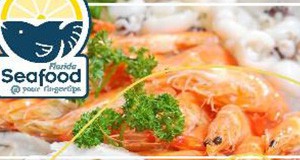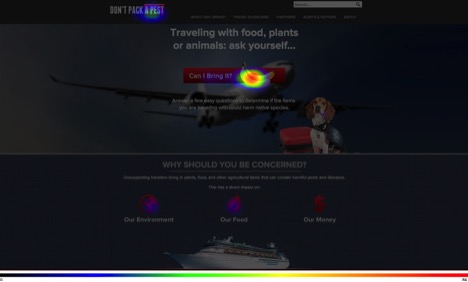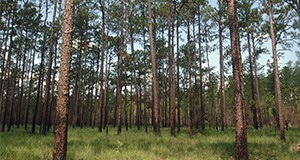 Media coverage of climate change can often leave the average person confused and unsure what to believe. However, as a trusted source of information and research, Extension has the opportunity to educate people about climate change and appropriate adaptation strategies in a scientific, unbiased way. This 5-page fact sheet outlines four challenges of climate change education. Written by Martha Monroe, Claire Layman Bode, and Mark A. Megalos, and published by the UF School of Forest Resources and Conservation, May 2015.
Media coverage of climate change can often leave the average person confused and unsure what to believe. However, as a trusted source of information and research, Extension has the opportunity to educate people about climate change and appropriate adaptation strategies in a scientific, unbiased way. This 5-page fact sheet outlines four challenges of climate change education. Written by Martha Monroe, Claire Layman Bode, and Mark A. Megalos, and published by the UF School of Forest Resources and Conservation, May 2015.
http://edis.ifas.ufl.edu/fr392
Category: Program Development
Seafood Knowledge, Perceptions, and Use Patterns in Florida: Findings from a 2013 Survey of Florida Residents
Over the past few years, consumers have begun to pay more attention to the nutritional benefits, sustainability, and environment impact of consuming seafood. However, media coverage of these concerns may leave consumers confused and uncertain about how they should incorporate seafood into their diets. In 2013, a survey was conducted to better understand Florida seafood consumer preferences, perceptions, and concerns. This 4-page fact sheet explains the survey’s findings and how they might help Extension deliver effective seafood-based education to Florida residents. Written by Lisa Krimsky, Charles Adams, and Bryan Fluech, and published by the UF Department of Food and Resource Economics, May 2015. http://edis.ifas.ufl.edu/fe965
Observation Bee Hives

The use of observation bee hives continues to interest a variety of people. This is not surprising. The observation hive is one of the primary research and educational tools in apiculture. It is both educational and entertaining. Observation bee hives can be used to enhance public relations and marketing programs. But a great deal of time and energy is needed to set up a hive and keep it going. Maintenance can be expensive and time consuming, especially if the hive is to be used as a permanent display for the general public. This 3-page fact sheet provides sources for building observation hives and tips for maintenance. Written by David Hall, James D. Ellis, and Malcolm Sanford, and published by the UF Department of Entomology and Nematology, March 2015. (UF/IFAS photo by Tyler Jones)
http://edis.ifas.ufl.edu/mg320
Perceptions of Florida-Friendly Landscapes: Linking Visual Quality and Environmental Health through Landscape Codes
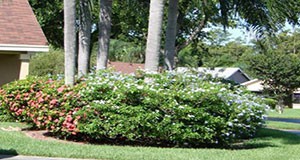
Early efforts to promote Florida-Friendly landscapes emphasized the use of drought-tolerant plants, which created a negative association with a visually unappealing landscape. This has hampered the promotion of FFL yards and the adoption by homeowner associations. But recently many homeowners are rethinking their landscape maintenance and plant choices and HOAs are considering promoting environmentally friendly landscapes but express uncertainty about recommending FFL because of the need to maintain visual quality. We conducted a study to address both groups’ concerns and help develop FFL-oriented landscape codes that meet both groups’ needs. This 7-page fact sheet was written by Gail Hansen, Laura Warner, Paul Monaghan, Emily Ott, Tim Fogarty, Claire Lewis, and Esen Momol, and published by the UF Department of Environmental Horticulture, April 2015.
http://edis.ifas.ufl.edu/ep519
Encouraging Landscape Water-Conservation Behaviors: Information Seeking Preferences of Florida Residents Who Use Irrigation in the Home Landscape
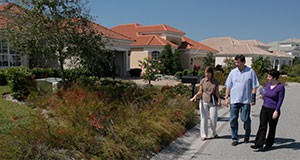 How can we encourage Florida residents who irrigate their home landscapes to adopt environmentally responsible irrigation practices? Provide them information they are interested in and deliver it through their preferred information channels. This 4-page fact sheet discusses the topics of interest to this audience and how they prefer to receive information about water-conservation practices related to their home landscaping, and makes recommendations for reaching this audience. Written by Courtney Owens, Laura Warner, Joy Rumble, Alexa Lamm, Emmett Martin, Randall Cantrell, and published by the UF Department of Agricultural Education and Communication, April 2015. (UF/IFAS Photo by Thomas Wright)
How can we encourage Florida residents who irrigate their home landscapes to adopt environmentally responsible irrigation practices? Provide them information they are interested in and deliver it through their preferred information channels. This 4-page fact sheet discusses the topics of interest to this audience and how they prefer to receive information about water-conservation practices related to their home landscaping, and makes recommendations for reaching this audience. Written by Courtney Owens, Laura Warner, Joy Rumble, Alexa Lamm, Emmett Martin, Randall Cantrell, and published by the UF Department of Agricultural Education and Communication, April 2015. (UF/IFAS Photo by Thomas Wright)
http://edis.ifas.ufl.edu/wc204
Integrating Critical Thinking into Extension Programming #1: Critical Thinking Defined
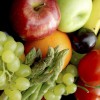 This 3-page fact sheet, the first in a series on integrating critical thinking into extension programming, defines critical thinking to assist extension professionals in better understanding the concept. Written by Alexa J. Lamm, and published by the UF Department of Agricultural Education and Communication, April 2015.
This 3-page fact sheet, the first in a series on integrating critical thinking into extension programming, defines critical thinking to assist extension professionals in better understanding the concept. Written by Alexa J. Lamm, and published by the UF Department of Agricultural Education and Communication, April 2015.
http://edis.ifas.ufl.edu/wc206
Integrating Critical Thinking into Extension Programming #2: Developing Critical Thinking Skills
 This 3-page fact sheet is the second in a series on integrating critical thinking into Extension programming, and examines the virtues of critical thinking to offer suggestions for integrating activities that encourage critical thinking into Extension programming. Written by Alexa J. Lamm, and published by the UF Department of Agricultural Education and Communication, April 2015.
This 3-page fact sheet is the second in a series on integrating critical thinking into Extension programming, and examines the virtues of critical thinking to offer suggestions for integrating activities that encourage critical thinking into Extension programming. Written by Alexa J. Lamm, and published by the UF Department of Agricultural Education and Communication, April 2015.
http://edis.ifas.ufl.edu/wc207
Integrating Critical Thinking into Extension Programming #3: Critical Thinking Style
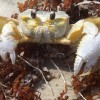 This 3-page fact sheet is the third in a series on integrating critical thinking into Extension programming. It introduces the concept of critical thinking style and describes the two styles of critical thinking. Written by Alexa J. Lamm, and published by the UF Department of Agricultural Education and Communication, April 2015.
This 3-page fact sheet is the third in a series on integrating critical thinking into Extension programming. It introduces the concept of critical thinking style and describes the two styles of critical thinking. Written by Alexa J. Lamm, and published by the UF Department of Agricultural Education and Communication, April 2015.
http://edis.ifas.ufl.edu/wc208
Introduction to Social Network Research: General Introduction and Major Terminology
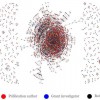 Social networks play an important role in the functioning of society and have an important effect on the actions of an individual or organization. It is very important for Extension educators to understand the networks of their clientele in order to perform better and develop more impactful Extension programming for their target audiences. This 5-page fact provides a brief description of network concepts and the terminology used in network studies, so that Extension educators may be more comfortable interpreting and using the results of SNA research to improve the efficiency and productivity of Extension organizations. Written by Anil Kumar Chaudhary and Laura A. Warner, and published by the UF Department of Agricultural Education and Communication, February 2015.
Social networks play an important role in the functioning of society and have an important effect on the actions of an individual or organization. It is very important for Extension educators to understand the networks of their clientele in order to perform better and develop more impactful Extension programming for their target audiences. This 5-page fact provides a brief description of network concepts and the terminology used in network studies, so that Extension educators may be more comfortable interpreting and using the results of SNA research to improve the efficiency and productivity of Extension organizations. Written by Anil Kumar Chaudhary and Laura A. Warner, and published by the UF Department of Agricultural Education and Communication, February 2015.
http://edis.ifas.ufl.edu/wc195
Introduction to Social Network Research: Application of Social Network Analysis in Extension
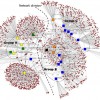 Viewed from a network perspective, we are all part of a network of relationships that is interwoven like a fishing net, providing both opportunities for and constraints on our behavior. Social network analysis (SNA) is a new approach to defining and describing society and its organizations and to assessing the impact of organizational structures. This 4-page fact sheet introduces Extension educators to possible ways to apply SNA in their work to plan and evaluate programs in a more efficient way. Written by Anil Kumar Chaudhary and Laura A. Warner, and published by the UF Department of Agricultural Education and Communication, February 2015.
Viewed from a network perspective, we are all part of a network of relationships that is interwoven like a fishing net, providing both opportunities for and constraints on our behavior. Social network analysis (SNA) is a new approach to defining and describing society and its organizations and to assessing the impact of organizational structures. This 4-page fact sheet introduces Extension educators to possible ways to apply SNA in their work to plan and evaluate programs in a more efficient way. Written by Anil Kumar Chaudhary and Laura A. Warner, and published by the UF Department of Agricultural Education and Communication, February 2015.
http://edis.ifas.ufl.edu/wc196
Introduction to Social Network Research: Brokerage Typology?
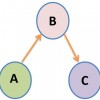 Brokerage occurs constantly in our daily lives. You, an Extension educator, want to deliver a financial management program in two neighborhoods, A and B. Neighborhood A needs help immediately, but you have no connections there. You do have connections in the other neighborhood, and you know that a family in Neighborhood A has friends in Neighborhood B. In this example, the Neighborhood A family can be a broker to help you deliver a program in Neighborhood B. Extension educators can use brokerage typology to understand how information and resources flow among their target audiences, and by identifying the brokers in their local communities, to increase the connectedness of communities and expand the reach of Extension programs to a larger population. This 5-page fact sheet was written by Anil Kumar Chaudhary and Laura A. Warner, and published by the UF Department of Agricultural Education and Communication, March 2015.
Brokerage occurs constantly in our daily lives. You, an Extension educator, want to deliver a financial management program in two neighborhoods, A and B. Neighborhood A needs help immediately, but you have no connections there. You do have connections in the other neighborhood, and you know that a family in Neighborhood A has friends in Neighborhood B. In this example, the Neighborhood A family can be a broker to help you deliver a program in Neighborhood B. Extension educators can use brokerage typology to understand how information and resources flow among their target audiences, and by identifying the brokers in their local communities, to increase the connectedness of communities and expand the reach of Extension programs to a larger population. This 5-page fact sheet was written by Anil Kumar Chaudhary and Laura A. Warner, and published by the UF Department of Agricultural Education and Communication, March 2015.
http://edis.ifas.ufl.edu/wc197
Using Heat Maps to Determine the Usability of Extension Communication Materials
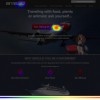 This heat map from a website usability test shows that more people click on the banana image than anywhere else on the computer screen, followed by the button at the top of the screenshot. This tool allows Extension faculty to determine the ease of respondent use of the communication material. This 6-page fact sheet explains how to use heat maps and how to develop heat map questions in Qualtrics. Written by Laura M. Gorham, Shuyang Qu, Ricky Telg, and Alexa Lamm, and published by the UF Department of Agricultural Education and Communication, February 2015.
This heat map from a website usability test shows that more people click on the banana image than anywhere else on the computer screen, followed by the button at the top of the screenshot. This tool allows Extension faculty to determine the ease of respondent use of the communication material. This 6-page fact sheet explains how to use heat maps and how to develop heat map questions in Qualtrics. Written by Laura M. Gorham, Shuyang Qu, Ricky Telg, and Alexa Lamm, and published by the UF Department of Agricultural Education and Communication, February 2015.
http://edis.ifas.ufl.edu/wc198
Conducting Interviews for News Stories
 In order to write a good news story for print, television, or radio, you have to conduct interviews with the people who have the information you need. An interview is the process of asking good questions so you can get good answers for your news story. This 3-page fact sheet provides some tips to follow as you conduct a news story interview. Written by Ricky Telg, and published by the UF Department of Agricultural Education and Communication, January 2015. (Photo: VStock/Thinkstock.com)
In order to write a good news story for print, television, or radio, you have to conduct interviews with the people who have the information you need. An interview is the process of asking good questions so you can get good answers for your news story. This 3-page fact sheet provides some tips to follow as you conduct a news story interview. Written by Ricky Telg, and published by the UF Department of Agricultural Education and Communication, January 2015. (Photo: VStock/Thinkstock.com)
http://edis.ifas.ufl.edu/wc194
News Writing for Television and Radio
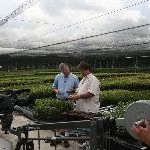 Creating a television or radio story is more than hitting “record” on a video camera or audio recorder. You have to learn the process of writing an effective television and radio news story first. This 4-page fact sheet was written by Ricky Telg, and published by the UF Department of Agricultural Education and Communication, January 2015.
Creating a television or radio story is more than hitting “record” on a video camera or audio recorder. You have to learn the process of writing an effective television and radio news story first. This 4-page fact sheet was written by Ricky Telg, and published by the UF Department of Agricultural Education and Communication, January 2015.
http://edis.ifas.ufl.edu/wc193
Grammar and Punctuation
 Any news story should be as free of grammar and punctuation errors as possible. Grammar is a system of rules that defines the use of the language. Most of the grammar and punctuation rules you have learned in school will be the same when using Associated Press Style, but there are some differences. This 4-page fact sheet covers some common grammatical and punctuation issues for journalists. Written by Ricky Telg, and published by the UF Department of Agricultural Education and Communication, January 2015. (Photo: iStock/Thinkstock)
Any news story should be as free of grammar and punctuation errors as possible. Grammar is a system of rules that defines the use of the language. Most of the grammar and punctuation rules you have learned in school will be the same when using Associated Press Style, but there are some differences. This 4-page fact sheet covers some common grammatical and punctuation issues for journalists. Written by Ricky Telg, and published by the UF Department of Agricultural Education and Communication, January 2015. (Photo: iStock/Thinkstock)
http://edis.ifas.ufl.edu/wc192
News Writing for Print
 A good print news story will contain the following components: inverted pyramid structure, five Ws and H, leads, impersonal reporting, news writing techniques, quotations and attributions, Associated Press Style, and proper grammar and punctuation. This 5-page fact sheet was written by Ricky Telg, and published by the UF Department of Agricultural Education and Communication, January 2015.
A good print news story will contain the following components: inverted pyramid structure, five Ws and H, leads, impersonal reporting, news writing techniques, quotations and attributions, Associated Press Style, and proper grammar and punctuation. This 5-page fact sheet was written by Ricky Telg, and published by the UF Department of Agricultural Education and Communication, January 2015.
http://edis.ifas.ufl.edu/wc191
News Media Writing
 Knowing how to write in a news media style is important not only for an organization’s reporters, but also for its members. This 2-page fact sheet provides an overview of news writing for print, television, and radio to help you better communicate news about what is going on in your organization. Written by Ricky Telg, and published by the UF Department of Agricultural Education and Communication, January 2015.
Knowing how to write in a news media style is important not only for an organization’s reporters, but also for its members. This 2-page fact sheet provides an overview of news writing for print, television, and radio to help you better communicate news about what is going on in your organization. Written by Ricky Telg, and published by the UF Department of Agricultural Education and Communication, January 2015.
http://edis.ifas.ufl.edu/wc190
The Savvy Survey #8: Pilot Testing and Pre-Testing Questionnaires
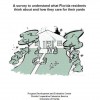 It is a good practice to pre-test a questionnaire after the initial design and formatting are completed. Based on studies conducted by researchers, pre-testing can be implemented using various methods. A number of possible pre-testing methods are described in this 6-page fact sheet was written by Anil Kumar Chaudhary and Glenn D. Israel, and published by the UF Department of Agricultural Education and Communication, December 2014.
It is a good practice to pre-test a questionnaire after the initial design and formatting are completed. Based on studies conducted by researchers, pre-testing can be implemented using various methods. A number of possible pre-testing methods are described in this 6-page fact sheet was written by Anil Kumar Chaudhary and Glenn D. Israel, and published by the UF Department of Agricultural Education and Communication, December 2014.
http://edis.ifas.ufl.edu/pd072
How Problems Gain Speed and Become Contentious Issues Through Agenda Setting
 A significant number of problems, like poverty, crime, and lack of resources, face people in the world today. This 4-page fact sheet discusses how a problem draws political attention through agenda setting and becomes a public issue, discusses the role the media plays in agenda setting, and provides a brief commentary on the influence of interest groups on public issues. Written by Courtney T. Owens and Alexa J. Lamm, and published by the UF Department of Agricultural Education and Communication, December 2014. (Photo: iStock/Thinkstock)
A significant number of problems, like poverty, crime, and lack of resources, face people in the world today. This 4-page fact sheet discusses how a problem draws political attention through agenda setting and becomes a public issue, discusses the role the media plays in agenda setting, and provides a brief commentary on the influence of interest groups on public issues. Written by Courtney T. Owens and Alexa J. Lamm, and published by the UF Department of Agricultural Education and Communication, December 2014. (Photo: iStock/Thinkstock)
http://edis.ifas.ufl.edu/wc177
The Florida Natural Resources Leadership Institute
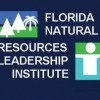 We are all dependent on Florida’s natural resources for jobs, health, and our quality of life. Decisions about the management and conservation of the State’s environment involve complex sets of issues and stakeholders. Expensive and time-consuming disputes often emerge over topics such as endangered species, land use, coastal and marine resources, and water quality and quantity. Effective leadership in managing such issues requires a specialized set of skills, tools, and strategies to build trust and promote innovation and collaboration among competing interests. To meet these needs, the Florida Natural Resources Leadership Institute (NRLI) was founded in 1998 to bring together professionals and stakeholders from diverse natural resource sectors to develop the skills required to engage the public and one another in collaborative decision-making. This 4-page fact sheet was written by Paul Monaghan, Emily Ott, Carol Lippincott, Ondine Wells, Jessica Ireland, Jon Dain, Bruce Delaney, and Roy Carriker, and published by the UF Department of Food and Resource Economics, December 2014.
We are all dependent on Florida’s natural resources for jobs, health, and our quality of life. Decisions about the management and conservation of the State’s environment involve complex sets of issues and stakeholders. Expensive and time-consuming disputes often emerge over topics such as endangered species, land use, coastal and marine resources, and water quality and quantity. Effective leadership in managing such issues requires a specialized set of skills, tools, and strategies to build trust and promote innovation and collaboration among competing interests. To meet these needs, the Florida Natural Resources Leadership Institute (NRLI) was founded in 1998 to bring together professionals and stakeholders from diverse natural resource sectors to develop the skills required to engage the public and one another in collaborative decision-making. This 4-page fact sheet was written by Paul Monaghan, Emily Ott, Carol Lippincott, Ondine Wells, Jessica Ireland, Jon Dain, Bruce Delaney, and Roy Carriker, and published by the UF Department of Food and Resource Economics, December 2014.
http://edis.ifas.ufl.edu/fe667
